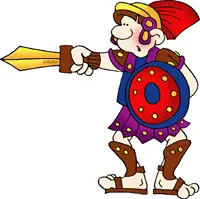Trajans Column
Roman Emperors liked to celebrate themselves by building monuments and especially after a decisive victory in battle. Trajan’s Column is one such monument that still exists in Rome.
The column was constructed to commemorate Emperor Trajan’s victory over the kingdom of Dacia in the first decade of 100 C.E. Trajan’s Column is a testament to his quality skills as a soldier-emperor in ancient Rome.
The column was constructed in 113 C.E. and is located in area known as Trajan’s Forum near the Quirinal Hill just north of the Roman Forum.
Trajan’s Victory over the kingdom of Dacia
Roman Emperor Trajan was the second Roman emperor of the Five Good Emperors of ancient Rome. He ruled from 98 C.E. until his death in 117 C.E. Trajan was considered one of the greatest Roman Emperors of all time.
He was a superb commander in the field at times of war and a just ruler to the people of ancient Rome. Trajan expanded the Roman Empire every time possible during his reign.
Trajan led the Roman army to victory against the kingdom of Dacia which was in present-day Romania two different times in 102 C.E. and 106 C.E.
He was instrumental in defeating the Dacians who were considered barbarians at the time. The victory brought much wealth to ancient Rome by securing the gold mines in the area.
Trajan’s Column
Trajan’s Column was finished being built in 113 C.E. Historians believe the famed architect named Apollodorus of Damascus was in charge of the construction.
The column is instrumental in helping researchers know more about the history of ancient Rome.
Trajan’s Column is massive and tall. The column towers above Rome some 115 feet (35 meters) into the sky. The column itself stands 98 feet (30 meters) and the pedestal is an additional 18 feet (six meters) high.
The main shaft of Trajan’s Column is composed of 20 hollowed blocks of Carrara marble. Each hollowed block weighs an estimated 32 tons and the blocks have a diameter of 12 feet (4 meters).
The hollow blocks wind around the column on the outside to form an area of 620 feet (190 meters). The winding area is inscribed with specific scenes of ancient Rome from the two Dacia Wars.
The design on the column depicts one clear theme that highlights the triumph of civilization over the barbarians. The theme portrays the Romans as clean cut people and the barbarians as rough unshaven people.
The upper portion of Trajan’s Column displays battle scenes from the first Dacia War in 102 C.E. The lower portion portrays similar scenes from the second Dacia War in 106 C.E. The carvings are very detailed showing weapons, shields, and other battle armaments used by both sides during the conflict.
For instance the barbarians wear leggings whereas the Roman soldiers did not wear leggings. The images are carved in a continuous manner but are separated by a Victory Shield. All in all there are more than 2,500 figures carved on the column along with 59 carvings of Trajan.
The top of the column once held a statue of Emperor Trajan but this was replaced in 1588 C.E. with a statue of St. Peter. The top blocks of the column weigh an estimated 53 tons.
The base is inscribed with praise for Trajan and gives a brief history of his life and rise to power.
Inside Trajan’s Column there is a 185 spiral staircase that leads to the top platform. When Emperor Trajan died in 117 C.E. his ashes were put on the inside of the column. The ashes have since been removed to another location.
Legacy of Trajan’s Column
Trajan’s Column is a true testament to the superb engineering and architectural skills of ancient Rome. The design that winds down the column was once believed to be propaganda.
Some researchers believe the column was used as a measuring stick for the construction of the forum.
Facts about Trajan’s Column
- Trajan was the emperor of Rome from 98 C.E. until 117 C.E. He was the second of the Five Good Emperors.
- Emperor Trajan was considered a soldier-emperor because of his leadership skills in battle.
- He was instrumental in defeating the kingdom of Dacia in 102 C.E. and 106 C.E. which is located in present-day Romania. The conquered territory brought wealth to ancient Rome because of the gold mines.
- Trajan’s Column was finished in 113 C.E. and celebrates Trajan’s victories over the kingdom of Dacia.
- The column is built with 20 hollow Carrara marble blocks that weigh 32 tons each. The column contains a 185 spiral staircase that leads to the top platform.
- Trajan’s Column contains a 625 feet (190 meters) winding picture carved into Carrara marble. The carvings display the two Dacia Wars and include detailed information about the soldier’s weaponry and clothing.
- The top of Trajan’s Column once was adorned with a statue of Emperor Trajan but it was replaced by a statue of St. Peter in 1588 C.E.
- The overall theme of Trajan’s Column suggests that civilization (the Romans) conquered the barbarians (the Dacians).
- Trajan’s Column contains more than 2,500 carvings of people and 59 carvings of Emperor Trajan.
What did you learn?
- What type of marble was Trajan’s Column built of?
Carrara marble
- What does Trajan’s Column memorialize?
Rome’s victory over the kingdom of Dacia
- Emperor Trajan was considered what type of emperor?
Soldier-emperor
- How much did each hollow block of marble weigh?
32 tons
- Trajan’s statue on the top of the column was replaced by a statue of whom?
St. Peter



